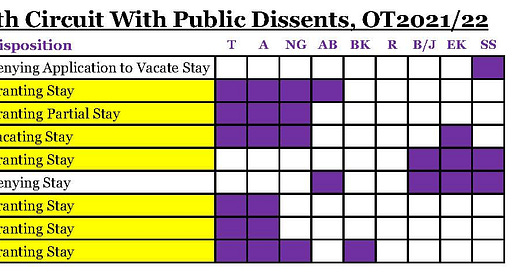Bonus 40: Ghost Guns and the Fifth Circuit's Track Record
In staying another nationwide injunction by a Texas district judge, the Supreme Court once again disagreed with the Fifth Circuit. At some point, the justices ought to acknowledge this growing pattern
Welcome back to the weekly bonus content for “One First.” Although Monday’s regular newsletter will remain free for as long as I’m able to do this, much of Thursday’s content is behind a paywall to help incentivize those who are willing and able to support the work that goes into putting this newsletter together every week. I’m grateful to those of you who are already paid subscribers, and hope that those of you who aren’t will consider a paid subscription if your circumstances permit:
One of the central distinctions between the substance of Monday’s free issues and that of Thursday’s bonus content is the personalization of the latter. To that end, I wanted to use today’s installment, as promised on Monday, to reflect a bit on last week’s 5-4 ruling in the “ghost guns” case, in which the justices put on hold a nationwide injunction from Judge Reed O’Connor that had blocked the Biden administration’s limits on the sale of kits to produce “ghost guns.” As I noted on Monday, neither the five justices in the majority (with Chief Justice Roberts and Justice Barrett joining the three Democratic appointees) nor the four dissenters explained their votes, so we’re left to speculate as to exactly why everyone voted as they did.
One of the less persuasive takes out there is that this is all about Justice Barrett—and that the ruling is part of a pattern in which Justice Barrett votes for emergency relief only to reverse “conservative” decisions by the Fifth Circuit. As I noted on whatever we’re calling Twitter these days, that view requires ignoring more than half of Justice Barrett’s votes for emergency relief during the relevant time period (votes that rather categorically undermine the thesis).
Instead, whatever the specific but unarticulated reasons for why the Chief Justice and Justice Barrett chose to vote for emergency relief in this case, it seems to me that the far more important point is the growing pattern the decision reflects—in which a district judge in the Fifth Circuit issues some kind of extreme ruling against a federal policy, the Fifth Circuit refuses to stay all or part of that ruling, and the justices are forced to intervene. And if you buy that this is a pattern (which I attempt to demonstrate below the fold), then it says quite a bit more about the Fifth Circuit than it says about the Supreme Court. The question is whether anyone on the Court is willing to say it themselves.
For those who are not paid subscribers, the next free installment of the newsletter (about the Supreme Court and … the federal officer removal statute) will drop on Monday morning. For those who are, please read on.
Keep reading with a 7-day free trial
Subscribe to One First to keep reading this post and get 7 days of free access to the full post archives.



